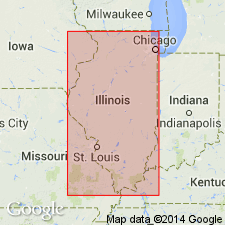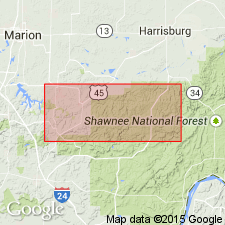
- Usage in publication:
-
- Reynoldsburg coal member
- Modifications:
-
- Named
- Dominant lithology:
-
- Coal
- AAPG geologic province:
-
- Illinois basin
Summary:
Reynoldsburg Coal Member of Abbott Formation. Reynoldsburg assigned to member status in Abbott formation (new). Occurs at base of formation below Grindstaff sandstone member. Coal name first used by J.M. Weller (1940). Age is Pennsylvanian.
Source: GNU records (USGS DDS-6; Reston GNULEX).

- Usage in publication:
-
- Reynoldsburg Coal Bed
- Modifications:
-
- Revised
- Age modified
- AAPG geologic province:
-
- Illinois basin
Summary:
The Reynoldsburg Coal Bed (rank reduced) occurs near the base of the Abbott division here informally called the basal Abbott shale and sandstone. Reynoldsburg reduced in rank because of its discontinuous occurrence. (Only widespread, continuous coals are retained at member rank in this report.) Coal has been mapped by authors in S1/2, sec. 31 and 32, and in parts of adjacent sections, along Cedar Creek. Coal, before mining, was 27 to 31 in. thick at the Ozark mine. Unit reaches a maximum thickness of 36 in. in the Reynoldsburg area and thins rapidly west of the Cedar Creek drainage. The Tunnel Hill Coal Bed (new name) crops out 40 to 70 ft above the Reynoldsburg. Reynoldsburg has been dated palynologically as late Morrowan (Early Pennsylvanian). This extends the age of the Abbott.
Source: GNU records (USGS DDS-6; Reston GNULEX).

- Usage in publication:
-
- Reynoldsburg Coal Bed
- Modifications:
-
- Revised
- AAPG geologic province:
-
- Illinois basin
Summary:
Reynoldsburg Coal Bed is here assigned to the informal Ferne Clyffe member of the Tradewater. Tradewater Formation of McCormick Group in the Goreville quad. is subdivided into two informal mapping units, the lower Tradewater and the upper. These two units were mapped originally as the Abbott and Spoon Formations, but this earlier nomenclature was abandoned midway through the COGEOMAP project. The term Tradewater was adopted from KY and applied to this interval of rocks in IL as part of an agreement with the IN and KY Surveys to standardize Pennsylvanian terminology in the Illinois basin. The top of the lower Tradewater is mapped as the top of the Murray Bluff Sandstone Member (a correlative of the Bernadotte Sandstone Member of Willman, 1975). The remainder of the lower Tradewater is subdivided into the ascending informal Ferne Clyffe member, Cedar Creek sandstone lentil, and Lake of Egypt member. The Reynoldsburg Coal Bed occurs near the base of the Ferne Clyffe. The informal Bethlehem sandstone lentil occupies the approximate middle of the upper Tradewater. Unit unconformably underlies Quaternary strata and overlies the Pounds Sandstone Member of the Caseyville Formation. Age of the Reynoldsburg shown as Middle Pennsylvanian (Morrowan). [Morrowan here considered to be both Early and Middle Pennsylvanain.]
Source: GNU records (USGS DDS-6; Reston GNULEX).
For more information, please contact Nancy Stamm, Geologic Names Committee Secretary.
Asterisk (*) indicates published by U.S. Geological Survey authors.
"No current usage" (†) implies that a name has been abandoned or has fallen into disuse. Former usage and, if known, replacement name given in parentheses ( ).
Slash (/) indicates name conflicts with nomenclatural guidelines (CSN, 1933; ACSN, 1961, 1970; NACSN, 1983, 2005, 2021). May be explained within brackets ([ ]).

